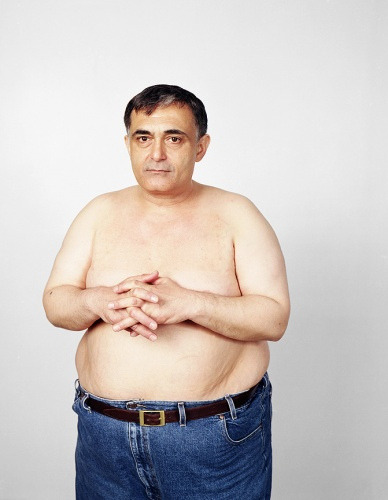JONATHAN CHERRY: Apart from Collier Schorr and Laurel Nakadate what other photographers influence your practice and why?
SIGRID JAKOB: Peter Hujar would be a photographer who has influenced me. He photographed people in this really loving way, with so much tenderness and acceptance. And that’s true even when he photographs animals, or the corpses in the Palermo catacombs. And I love how low-fi his portraits are - all he needed was an old blanket or chair, and some bare-bones lighting. And yet, you can’t stop looking at them.
I also like some of Gillian Wearing’s work. She’s done some simple and beautiful investigations to find out what’s behind the public face that we all put forward, to get at some of the pain and insecurity and boredom and strangeness behind it.
JC: Could you briefly talk about some of the ideas behind the series ‘Bears’?
SJ: On the surface it looks like a straight-forward documentation of a subculture – gay guys who are happy to be large and hairy. I wanted it to be a bit more though. What makes bears so interesting to me is that they are this utopian community of men who have decided that traditional definitions of masculinity no longer work for them, and are inventing a new way of being a guy, sort of on the fly. And that is the thing that interests me most – how guys are adapting (or failing to adapt) to a world in which traditional definitions of masculinity are being eroded. In the bears’ case they’ve blended this nostalgic blue collar vision of what a ‘real’ man looks like like with a very warm, physical, nurturing way of interacting. It’s a rebellion against the ‘Ken doll’ physical ideal in the gay and straight world and the blustery toughness that goes with it.
In my pictures I wanted to show this tension – between defiance and the vulnerability, hyper-masculinity and the the softness that’s almost feminine (but not effeminate).
The other part of the project that turned out to be absolutely fascinating is the discovery that the reason many people wanted their picture taken is because they plan to use it for their personal profiles on dating websites like biggercity.com (where many of my images can still be found). To realize that my pictures have this second life, where they get used for people to get laid or find a partner, that they are this currency in this economy of images, is really satisfying to me. Because, rather than doing me a favor in modeling for me, my models get something valuable out of it too, which somehow makes it a more honest, equitable transaction.
JC: How did you come across the male models for your ‘Bears’ series?
SJ: Every single person in my photographs is a stranger I have found somewhere on the internet, often through a site like Craigslist.com. In the case of the ‘Bears’ series I was lucky in that there are a number active Bear Yahoo groups and Listservs. I simply posted my request with the approval of the moderators, explaining who I was and what I was trying to do. I got very lucky in that a got a lot of responses, by some really lovely people.
JC: For me, the majority of the ‘Bears’ portraits looks as if the models have a certain element of control. How did you approach this kind of subtly intrusive way of photographing? Was it hard/easy etc?
SJ: The shoots were situations of mutual vulnerability – here I am, this stranger, a straight woman, turning up at their doorstep and taking pictures of them where they bare everything. And there is me, not really knowing what I am doing, in a stranger’s home trying to take a picture that captures what is lovable about them. It only works when you let go of the photographer-model power dynamic, when both of you let down your guards and let your insecurity show. Together we’ll then try a lot of stuff, some of it goofy, some staged and some of it just very plain. I am always looking for the moment when people feel comfortable enough to let some of their vulnerability show. Shoots are rarely easy, and can be quite wrenching. But it worked most of the time, and I got to meet some really lovely people.
JC: How are you as a photographer trying to push the medium of photography forward?
SJ: Well, I am not sure whether I am really trying to push photography forward, but the thing that has always fascinated me most about the act of portrait photography, is that it is fundamentally just this awkward, muddled interaction - two insecure human beings looking at each other. Photographers across the ages have done a great job covering up this strange truth, with ever more elaborate props, poses and staging. I am really interested in stripping all that away, and letting some of that discomfort and vulnerability show through again. To see what happens when two people let down their guard and just look at each other.
JC: What did you have for breakfast today?
SJ: Porridge with some mushy raspberries that I picked yesterday
